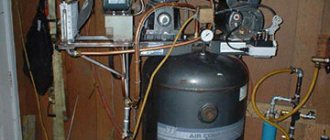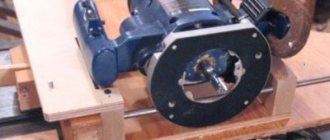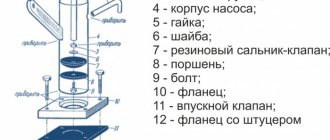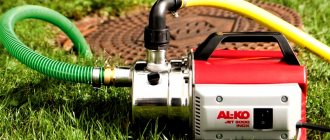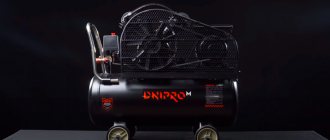Hello everyone, I have a Chinese-made compressor, two-piston. When changing the oil, when I drained it, it was green (I painted the car with a green base). Immediately the suspicion fell on the air filters that they were not doing their job, and indeed when I looked inside the filter I was shocked, there was a pathetic piece of foam rubber there.
the compress itself
op
filter. It was decided to improve this design. The choice fell on a filter element for an oil filter from a car.
I cut the housing and removed the filter itself.
After this, you need to drill a hole in the upper part of the filter for a pin, in my case M5, and also cut out a washer for sealing. Remove the glass in which the foam rubber is placed, then apply sealant and everything is assembled.
The same paper filter elements are found on more efficient Chinese compressors. It’s cheaper and faster to buy assembled from the older model. IMHO
Well, just not in my city, and I got a little wild))
Dude, the oil is in the compressor and should be green in the drain. Drain immediately what you poured in there before you get into serious problems. You filled it with compressor oil, but you poured it in with car oil. Is it okay that these oils have completely different lubricating properties and, most importantly, flash points? And I changed the filter - that's right. Install a good water-oil separator at the receiver outlet, preferably two stages. A compressor and an internal combustion engine are completely different units. I can take a photo of the oil from the compressors of my diesel locomotive and my garage compressor, if interested. It's green, just like it should be.
When questions like these are asked (about flash point, for example), the desire to write further disappears immediately, but the desire appears to follow the topic and see what happens next. So, why do you think they created specifically motor oil, specifically compressor oil, and, if I’m really going into the woods, transmission oil (which is also divided into oils for manual transmissions and automatic ones, and there are also oils for hypoid gears). In this case, flash point is an extremely important parameter. Motor oils contain a bunch of additives (detergents, antifoaming, antioxidants, etc.), plus it must be completely dissolved with the fuel and burn without residue. Compressor oil has a completely different set of additives, plus it has a completely different viscosity and flash point. As for the latter, google it in a search engine, smart people have covered it all over and over.
And now from personal experience. In my life I have seen more than one ruined compressor into which motor oil was poured. You poured liquid oil in there, of course, starting will be much easier. But when your compressor turns into a single-cycle diesel engine, I think there will be little laughter, as you will end up with a complete replacement of the compressor head. Because there will be nothing to restore there. And the most difficult experience was when on one of the diesel locomotives in winter they decided to dilute the oil in the compressor with diesel fuel. I think you can figure out the result yourself). If you don’t like the stock fluid, splurge on good compressor oil. There is no need to change it there for a long time, it is inexpensive. If you live in St. Petersburg, I can get you some excellent oil for that.
Unfortunately, I don’t live in St. Petersburg, are you saying that during prolonged operation the oil will begin to detonate? Yes, and I would like to know about the flash point.
At my last job, a FINI industrial piston compressor worked for more than five years without changing the oil; it was only topped up with all sorts of things, including the spindle. The filter was cleaned when a drop in productivity became noticeable, furniture production, there is a lot of dust there. When I left there six months ago, the compressor was still working and had no intention of dying.
What is the risk of foreign matter getting into the working part of the compressor?
- The mixing of moisture and oil residues results in an emulsion that can create blockages in the compressor channels through which air is supplied. The emulsion, by its composition, by definition, cannot meet the standards adopted for its use in industry, etc.
- When exposed to low temperatures, water entering the air supply ducts freezes, causing them to become clogged or damaged.
- Rust begins to form in the air supply channels, which sooner or later leads to air blockage.
- Moisture getting into a pneumatic tool leads to corrosion of parts and failure of the tool.
- The presence of moisture in the supplied air makes it impossible to create a high-quality surface coating.
Factory or homemade moisture-oil separator?
Unless you paint cars professionally, you probably don't feel the need to purchase a dehumidifier designed and assembled by any major manufacturer. The power of the device and the amount of paint that it is capable of passing through itself on an industrial scale greatly influence the price, which not every car owner is willing to pay.
What then should you do if you urgently need to paint, for example, a car fender or repaint it completely, but now you don’t have the money to go to a car paint shop ? You can try to make a dehumidifier with your own hands, as suggested in the video.
Below we will tell you how to assemble an effective, working, reliable dehumidifier.
There are three ways in which excess moisture is removed from the air entering the paint compressor:
- special filters;
- application of centrifugal force;
- exposure to low temperatures.
Scope of use of moisture separators
In principle, such devices are used almost everywhere where compressed air produced by a compressor is used - in paint shops, when cleaning workplaces. They are also installed in centralized air supply networks, for example, in stamping or forging shops. It is used to clean equipment installed in boiler rooms; plumbers use it to purge sewer systems.
Without compressed air, the work of departments that use pneumatic tools is impossible.
Most of the equipment used in drug production operates exclusively using air.
Automatic welding lines used in automobile body assembly are pneumatically driven and using an unrefined air stream will lead to early failure. And this will entail expensive repair work and a serious reduction in the service life of expensive technological equipment.
Industrial compressed air dryer design, operating principle and significance
A moisture separator is a filtration element that removes liquid from the air supplied to the compressor and ensures that the environment produced by the climate control equipment is optimal in composition and characteristics.
Water separators have different characteristics depending on their purpose:
- There are devices with a small filter capacity, but with fine cleaning.
- There are units with high throughput, but low filtration quality.
The first type is used in painting equipment, the second type is typical for climate control equipment, where filtration is assigned to other functional units.
Depending on the nature of filtration, there are two main types of dehumidifiers:
- Dehumidifiers: they only remove moisture and do not guarantee high-quality removal of solid particles.
- Moisture-oil separators: remove not only water from the air stream, but also oil-containing elements.
Read also: How to test a thyristor without desoldering it from the circuit
Three types of dehumidifiers are produced at the industrial level:
- Vortex: the operation of the device is based on the principles of processes in natural, climatic cyclones, when air rotates around a central axis and throws moisture onto the walls. Humid air has a high density, so it concentrates closer to the walls, where water droplets condense as it moves.
- Silicogel: the work is based on the use of absorbent material that absorbs moisture.
- Refrigeration: moisture removal occurs by passing air through the refrigeration tank.
The most widely used are vortex or cyclone types of devices. Here, from the air passed through the compressor, water is removed (retained) due to a special turbulence of the flows. Liquid particles settle on the surface.
To increase efficiency, the internal space of the vortex filter is equipped with special blades. They collect water particles on their surface, which are discharged into a special tank, where it is retained due to the presence of membranes.
For the effectiveness of dryers, the characteristic that determines the size of the separated water fraction is very important. At the industrial level, “thin” devices are produced that are capable of “catching” and purifying the flow of water particles with a fraction of about 5 microns. Most units remove water in a fraction of 10 to 15 microns.
The pressure generated is of great importance in determining the suitability of the dryer for a particular compressor. Thus, a filter drier for a mid-level compressor operates at maintained parameters of 6-8 bar.
This indicator does not affect operating efficiency, but is important for determining the optimal fit of parts for a particular compressor model. Pressure makes it possible to compare the power and loads that arise when passing compressed air.
Pros of installing a dehumidifier:
- Additional filtration, increasing air purification and removal of various impurities.
- Obtaining output air that is not oversaturated with moisture.
Installing a dehumidifier also has its drawbacks, so you should treat its equipment carefully. The disadvantages include the following factors:
- Mounting the unit increases the load on the main working base of the compression equipment.
- The wear of the device increases and the likelihood of breakdowns increases.
- There is a decrease in air volumes passed through, which affects efficiency and productivity.
Design and principle of operation
The design of the filter is not complicated. It consists of:
- A housing that is fixed to the pneumatic line and forms the basis for the moisture separator.
- A glass that forms a cavity into which a number of parts are installed, for example, a filter device, a valve, an impeller, a deflector.
The principle of operation is also not complicated. After the air flow enters the device body, it moves towards the impeller (impeller). She spins it and thus creates a centrifugal force that affects all microparticles in the air. They move towards the wall of the glass and settle on it, while rolling down. In order to separate the volume in which contaminants accumulate in the glass, a damper is provided. Over time, dirt accumulates, which is removed by hand through the stopper located at the bottom of the glass.
Air drying device for a compressor: DIY budget model
To make the paintwork smooth, uniform, and without defects, you can make an air dryer for a compressor at home with your own hands from scrap materials.
Method #1
- A gas cylinder is used as a reservoir.
- It is cut in cross section with a grinder to create a collapsible structure.
- It will be operated in an inverted vertical position. In this case, the shut-off valve (faucet) is located below.
- In the upper part of the cylinder, an inlet pipe with threads at the ends is welded strictly horizontally, with a slight offset to one of the walls of the cylinder, using welding.
- This will allow the air entering under pressure to create rotating jets directly at the walls.
- The outlet piece of the tube is welded strictly in the center at the top of the cylinder. In this case, the length of the pipe is about 2/3 of the length of the tank.
- Turning waste (chips) is poured inside as a filter element.
- A strainer is installed at the outlet end.
Method #2
You can make a filter element to remove moisture from compressed air for high-quality painting of garage equipment according to the second option, using silica gel.
- a piece of pipe 0.65 - 0.7 m long and 100 mm cross-section.
- sheet metal (thickness 3 mm);
- metal grid;
- used fire extinguisher;
- fasteners.
- A piece with smooth edges 50-55 cm in length is cut from the pipe.
- From one edge (this will be the top) a rectangular recess measuring 10x5 cm is made on the pipe wall. The hole should be covered with a mesh and be guided by its dimensions.
- The same cut is made diagonally on the other side of the pipe.
- Two pieces of mesh are tried on both cutouts and secured by welding so that the upper edges of the insert and the body strictly coincide.
- The remaining hollow cylinder of the pipe is cut in half lengthwise with a grinder.
- These fragments are placed on top and welded with a thoroughly strong seam.
- Since the iron is quite thick, manual arc welding is better suited for welding work. It makes seams on iron much better than the same semi-automatic machine.
- The result should be a cylindrical structure with semi-cylindrical bulges on both edges.
- The cap on the fire extinguisher is unscrewed.
- The neck and thread on it are cut off.
- The fire extinguisher cover is freed from unnecessary parts. All holes in it are tightly sealed.
- This cut-off threaded part is welded to the upper edge of the future filter.
- For a stable position, the structure on the opposite (lower) edge is equipped with a base: a piece of iron measuring 35-35 cm or other parameters is welded to the bottom of the filter.
- To cover the semi-cylindrical protruding parts from the bottom and top, three fragments in the form of a semicircle are cut out of metal. The curved edge of the rounded edge should match the diameter of the pipe. It is necessary that the semicircular parts fit tightly to the pipe and cover the unwelded areas.
- To fix such overlays, holes for bolts are cut in two of them (in those that will be on top). The third (blind) fragment is welded from below.
The result is a device containing a filling neck and a gearbox in the upper part. At the bottom there is a connecting pipe for air intake. The entire structure rests on a stable foundation. It must be checked for leaks by connecting a compressor. If the outcome is normal, silica gel is poured into the neck up to the mark of the lower edge of the upper mesh. The hoses are connected and the dryer is ready for use.
A homemade dehumidifier is an inexpensive option for removing condensation from the air flow and improving the quality of work.
https://youtube.com/watch?v=MeK1CQbJIIw
Types of air purification systems
To clean the air flow supplied to the compressor, the following types of filters are used:
- Using the cyclone principle in their work.
- Filled with moisture-absorbing material.
- Refrigeration operating principle.
Each type of device for purifying compressed air from moisture has its own set of advantages and disadvantages. To select the optimal device, it is advisable to have an idea of their operating schemes. At the same time, there are cleaning systems that can be used for both domestic and industrial purposes.
Those craftsmen who do not have enough time to assemble it themselves prefer to purchase an air dryer for compressors from specialized companies.
Advantage and importance of application
Moisture present in the air almost always has a detrimental effect on both the equipment and the processes that are carried out with its help. First of all, the compressor itself suffers, inside which the steam can partially turn into condensate, that is, liquid water. Water is known to promote the corrosion process.
Read also: Analyzers of the chemical composition of metals and alloys
The same can be said about all kinds of open pneumatic systems - for example, in trucks, into which the compressor periodically pumps air taken from the outside.
Water separator from Geyser filter
If a compressor is used to paint a car, then if there is moisture in the air, the coating will be of lower quality (so-called craters are formed), and the vehicle body may corrode.
By using a dehumidifier, it is possible to significantly dry the air entering the compressor, which means that all of the above phenomena can be avoided.
If you want to save on heating, install a battery tank. Accumulator tank in a heating system - advantages and disadvantages.
Read about the features of assembling and installing a chimney for a fireplace here.
Step-by-step instructions for making a bio-fireplace are presented in this topic.
Modular cleaning systems
Modular systems demonstrate the utmost quality of air purification. Structurally, such a system consists of several filter components:
The use of this type of filter device allows you to achieve almost ideal quality of the air flow supplied to the compressor. Such systems are installed at the final air preparation section.
Homemade cyclone type moisture separator
The principle underlying the operation of a home-made device is relatively simple. When the air flow enters this product, it begins to unwind. Under the influence of centrifugal force, foreign particles begin to move towards the wall of the product. Clean air enters the hole located at the bottom of the product, then it is supplied to the compressor inlet.
To make an oil separator with your own hands, you will need a pipe with the following parameters - a length ranging from 0.6 to 0.7 m and a diameter of 0.1-0.11 m. When selecting a workpiece, you must remember that the air flow will be supplied under high pressure, therefore its walls should be quite thick. So, it makes sense to think about making a cyclone from an old fire extinguisher. Immediately before manufacturing, it is necessary to clean the internal surface from corrosion. To do this, it is treated with abrasive sandpaper. This manual handling will reduce the likelihood of foreign parts getting into the compressor.
The sequence of making a cyclone with your own hands is something like this:
- At a distance of 120 mm from the bottom plug, it is necessary to weld a pipe into the wall through which air flow will flow
- It is advisable to weld the pipe so that its center line is located at a certain angle to the upper surface of the cyclone.
- It is necessary to weld a pipe in the center of the top plug to allow the purified air flow to exit.
- A drain pipe must be installed in the center of the bottom plug.
Important recommendations to help you make a homemade dehumidifier for a compressor
Based on what was written above, you can assume that making a reliable oil and moisture separator with your own hands is a simple matter that will not take much time and effort. This is true. At the same time, you should try very hard to ensure that the device turns out to be of high quality and performs the functions assigned to it, otherwise the paintwork of your car will not last long. To do this, you need to adhere to the following recommendations:
- Check your unit to ensure it meets compressor specifications. It may turn out that your homemade device will not be able to withstand the power of the spray gun;
- use high-quality materials for welding;
- check the fittings and pipes for trouble-free passage of the air mixture through them;
- use high-quality sealants and conduct a leak test of your product.
To improve the quality of car painting using a compressor, experts recommend additionally using a device such as a moisture separator. It reduces the humidity in the air needed to spray paint. If excess moisture is not removed, the body will corrode, and the paintwork itself will not last long.
Adsorber
Among the many materials that absorb moisture well, silica gel has excellent properties. You can buy it in stores in its pure form or in the form of litter for pets.
To calculate the volume of the required amount of this substance, you can use the following formula - for every 800 liters of air per minute you will need about 1 kg of silica gel.
A water filter can be used as a container for placing the sorbent.
Homemade cooler
Low air temperature allows moisture contained in the air flow directed to the compressor to collect (condense). Devices of this type are popular, especially among automotive repair specialists. The operation of a product of this type ensures a supply of air that meets all cleanliness requirements.
When making such a chamber with your own hands, you need to ensure a flow of air into the freezer. The main task that will need to be solved when manufacturing a cooler is to ensure the tightness of the refrigeration unit and make a fitting for removing moisture. For areas with cold climates, it is possible to supply air directly from the street. This move will allow you to obtain air with a low moisture concentration and, after minimal processing, send it to the compressor.
But you need to understand that producing a cooler with your own hands to purify the air is complex and entails considerable costs.
The most common types of homemade dehumidifiers
Experts recommend using the following types of dehumidifiers:
- cyclone type;
- absorbing moisture using silica gel;
- refrigeration type.
Each type has its own advantages and disadvantages. To choose the best option for yourself, you need to familiarize yourself with all the device diagrams. The designs use old cylinders, oil filters, and refrigeration equipment elements. Before starting work, make sure that you have a welding machine, a set of keys and screwdrivers, a drill, a hammer, glue and insulating material.
Homemade cyclone-type devices
The operating principle of a cyclone dehumidifier is quite simple. When a stream of compressed air enters the installation, it begins to rotate. Under the influence of centrifugal force, condensate, small particles of debris and oil are directed towards the walls. At this time, the purified air passes into the lower central hole and is then supplied to the compressor.
The air mixture is supplied through the upper hole; under the action of centrifugal force, the moisture is separated and discharged through the outlet pipe
To create a homemade centrifugal apparatus we will need:
- old propane tank;
- union;
- welding machine;
- two metal tubes of short length.
An old cylinder is perfect as a body; it has sufficient height and can withstand increased pressure. The work order is as follows:
- We install the product vertically, with the tap down.
- We weld the inlet fitting to the top of the housing.
It should be shifted closer to one of the walls of the cylinder. We weld the inlet fitting and the outlet pipe to the cylinder - We weld the outlet pipe to 2/3 of the height of the cylinder.
We install the cyclone moisture separator vertically, moisture will be removed through the lower hole with a valve
To improve the efficiency of the dehumidifier, you can add wood shavings inside and install a filter mesh at the outlet. But in this case, you will need to cut the body crosswise and, after finishing the work, fasten it back together using a special sealed gasket.
Silica gel dehumidifier
Silica gel allows you to filter the air mixture; you just need to correctly place a layer of this substance in the housing of the oil or water filter. Old equipment from Volga is ideal for creating a homemade dehumidifier.
- We disassemble the old oil filter.
We disassemble the old oil filter and prepare it for further work - As an inlet pipe, you can use the original tube through which oil was previously supplied.
- We plug the extra holes using bolts of the required diameter and sealant.
To plug the holes we use bolts of the required diameter and sealant - We reassemble in the reverse order, filling the free space with silica gel.
We fill all the free space of the case with silka gel - We put on the top cover and screw it tightly with a bolt.
Press the top cover firmly against the oil filter housing
The filter design has several brackets, with the help of which the filter can be easily installed in the desired place.
To get the most out of the silica gel, the inlet and outlet holes should be located at different ends of the body.
Refrigeration device
As you know, low temperatures allow moisture in the air mixture to condense. Refrigeration type dehumidifiers are quite popular among auto mechanics. The devices cover almost all requirements for the air supplied to the compressor. When creating a dehumidifier, it is necessary to direct the air flow through the freezer or other refrigeration equipment.
It is important to completely seal the freezer in the receiver and make a pipe to drain condensate. For residents of the “cold” regions of our country, experts recommend supplying air to the compressor from the street. In winter, you will directly receive an air mixture with a low moisture content.
Some features of making a dehumidifier with your own hands
It may seem that making this device with your own hands is quite simple, but you must always remember that poor quality work can lead to a negative impact on the quality of the work performed. For example, when working with pneumatic tools, interruptions in their operation may occur due to moisture and debris entering the turbine or bearing assembly. Or when coating the surface with varnish, coating defects will form. When assembling a dehumidifier with your own hands, you can use some practical tips:
- The body of this self-made device must be leak-tight and able to withstand high pressure.
- When installing pipes and fittings with your own hands, you must use welding and soldering. If possible, it is advisable to use semi-automatic welding performed in a shielding gas environment.
- The diameter of the installed pipes must ensure free passage of air flow into and out of the device.
- A home-made device, assembled with your own hands, must extremely accurately meet the requirements that the compressor imposes on air quality.
FakeHeader
Comments 31
What a moonshine still it turned out to be! Did you paint the inside? There will be condensation there. In general, these filters should be made according to the principle of a refrigerator: compressor - cooler - siphon - condenser - then a cat filter.
I'm wondering if you connect a pressure gauge at the output and turn on the gun. What real pressure will this filter and thin hoses let through? It doesn't seem like much to me. I generally consider the shortcut between filters to be a nonsense that only steals performance. It was necessary to twist everything straight, sequentially, or at least without quick releases.
The hoses are not that thin - 8mm. inner diameter. The productivity in liters/minute is more than enough for my purposes. Yes, and I did it for my own purposes. If someone wants to make inlets and outlets from an inch pipe and connect them with the same hoses, that’s his personal business, but I like it that way.
The outlet from the filter will quickly become clogged with dust from silica gel. The height of your washcloths (20 pieces) is also large. They just take up space. 5 at the bottom and 5 at the top would be enough. After the moisture eliminator, you place a filter flask made of polypropylene, not polycarbonate. It holds 16 atm. And there is a thread filter in it. Here's an example for you. But it's not a problem.
Why is there such confidence that silica gel will last for a year, or even more? Silica gel traps moisture until saturation occurs, and then the accumulated moisture must be evaporated from it. I don’t think that the volume you filled will be enough for such a period. Industrial drying plants operating on silica gel, as a rule, have two batteries that back up each other: while one is in operation, the other is dried (evaporated) by a heating element built into it.
I don’t have industrial production, so that’s why I’m thinking about such deadlines. For control, I installed a post filter; if moisture begins to appear on the flask, then it’s time to change the silica gel.
